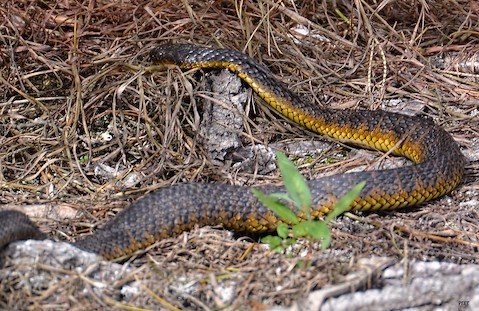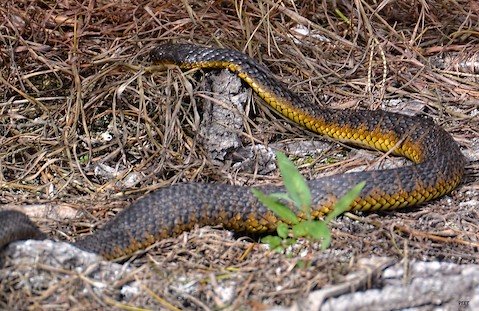Carved from the swamps,
we dredged your home to
make way for our own;
squaring the deal with
metals that were
no longer precious.
Their caustic arrival
painting our castoffs in
violent hues of indelible ink;
a technicolour of toxicity that
leached across the landscape.
Slithering through the sediment
like a scaled canary,
your yellowed bellies contort with pain;
gorged on the entrails
of poisonous frogs
that were once born benign
in the coal mines of the plains.

This poem is inspired by recent research, which has found the accumulation of heavy metals in the livers of tiger snakes to be indicative of wider environmental damage to wetland areas.
Many toxic heavy metals (such as copper, lead, and mercury) exist naturally in low concentrations, in the sediment of wetlands and their surrounding rocks. However, as wetlands are usually situated at low points in the landscape, a lot of urban pollution also ends up there, leading to an accumulation of these pollutants. Exposure to such contaminants can have a range of impacts on the health and behaviour of animals, including poorer health conditions, shorter lifespans, and ultimately, local extinction. Furthermore, the higher up the food chain an animal is the higher its dose of these contaminants, with these metals increasing at each level of the chain via a process known as bioaccumulation (defined as when an organism absorbs a substance at a rate faster than that at which the substance is lost, e.g. through excretion).
Tiger snakes are a top predator in a wetland environment, and as such they are susceptible to bioaccumulating large quantities of heavy metals, primarily through their consumption of frogs, which themselves are very sensitive to these contaminants. In this new study, researchers found that the livers of tiger snakes living in the wetlands of the Swan Coastal Plain in Perth, Western Australia, contained high levels of toxic heavy metals. In particular, snakes tested from Herdsman Lake (Perth’s most urbanised wetland area, in the north western suburbs of the city), were found to have the highest concentration of the heavy metal molybdenum ever reported in a terrestrial reptile, anywhere in the world. Furthermore, sediment samples taken from some of the wetland sites were found to have amounts of arsenic, lead, mercury, and selenium that exceed current government guidelines. As well as highlighting the current toxic levels in these wetland areas this research also demonstrates how snakes are a good bioindicator of wetland contamination, highlighting their role as an important indicator of environmental health.
If our reporting has informed or inspired you, please consider making a donation. Every contribution, no matter the size, empowers us to continue delivering accurate, engaging, and trustworthy science and medical news. Independent journalism requires time, effort, and resources—your support ensures we can keep uncovering the stories that matter most to you.
Join us in making knowledge accessible and impactful. Thank you for standing with us!

